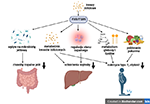The role of bile acids in the therapy of selected diseases
DOI:
https://doi.org/10.18388/pb.2021_506Abstract
The main function of bile acids (BA) is participation in the emulsification of dietary fats. Recently it has been discovered that BAs can also act as signaling molecules regulating the processes of their own synthesis and metabolism, as well as glucose and lipid metabolism. In addition, they affect the motility of the digestive tract and food intake. BA also interacts with the gut microbiota, a major player in their metabolism. Most of the regulatory actions of BAs are mediated by their receptors, the most important of which are the farnesoid X receptor (FXR) and the G protein-coupled receptor -TGR5, found in large amounts in the intestine, liver, adipose tissue and other tissues of the body. Recently, much attention has been paid to the influence of BA on various diseases and the possibility of using them in the treatment of e.g. inflammatory bowel disease, liver diseases, type 2 diabetes and obesity.

Published
Issue
Section
License
Copyright (c) 2024 Aleksandra Boguszewska, Anna Kiersztan

This work is licensed under a Creative Commons Attribution 4.0 International License.
All journal contents are distributed under the Creative Commons Attribution-ShareAlike 4.0 International (CC BY-SA 4.0) license. Everybody may use the content following terms: Attribution — You must give appropriate credit, provide a link to the license, and indicate if changes were made, ShareAlike — If you remix, transform, or build upon the material, you must distribute your contributions under the same license as the original. There are no additional restrictions — You may not apply legal terms or technological measures that legally restrict others from doing anything the license permits.
Copyright for all published papers © stays with the authors.
Copyright for the journal: © Polish Biochemical Society.



